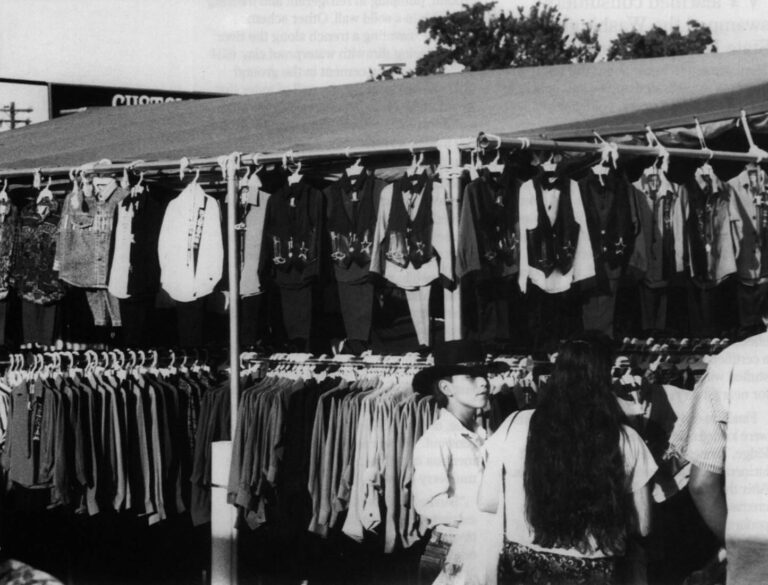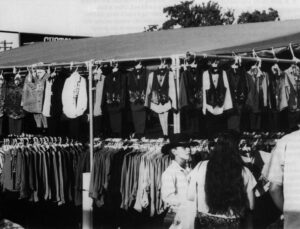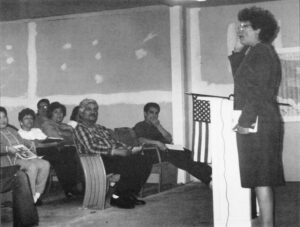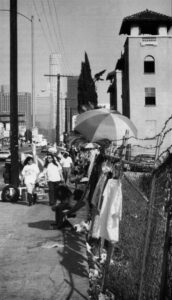One morning in September, 1978 Juan L. Chanax set out from his village in the Guatemalan highlands of Totonicapan and began a voyage with consequences still unfolding in unimaginable ways. A weaver’s son and a good weaver himself, Juan made one of the few decisions allowed to ordinary men that can change the history of nations. He decided to move.

He sold his looms for a few hundred dollars and with just a small valise in hand he headed north. Juan did not know anyone who had actually made the trip to the United States although he had heard talk about the good money to be made here. He ended up in Houston eventually where he found work mopping a supermarket floor. Since then more than 2,000 people have followed his way from Totonicapan to Houston.
“First my relatives came and then my friends came and then the relatives of my friends and then the friends of my friends’ relatives came,” said Juan, who is of Mayan stock and whose last name, Chanax, pronounced shah-natch, is in Quiche language.
When he waded across the Rio Grande that September 15 years ago, he created a link between Totonicapan and the United States. Juan was the first man to move, and over time his haphazard trail north has become a deep, broad channel that carries a steady human traffic between two worlds.
Virtually all the immigrants from Totonicapan form part of a tightly knit network that has etched itself into Houston’s urban landscape. Most of them work for the same supermarket chain where Juan first found a steady job. They live in a cluster of suburban apartment complexes that has become a faux Georgian, Mayan barrio amid the strip malls. They are evangelical Christians and have taken over at least two small churches and have raised one of their own. In 1981, Juan and other immigrants from his hometown of San Cristobal organized a soccer team. That endeavor has grown into a 26-team league.

In San Cristobal, a town of 4,000 where not all the streets are paved, land now costs as much as it does in Guatemala’s largest cities. The price has been bid up by the Houston grocery workers who use their dollars to build vacation and retirement homes. Meanwhile, those who staid behind live in old adobe houses that look like miniature K-Marts. China cabinets sag under the tape recorders, food processors, hair dryers and other booty brought back from Texas as gifts.
Every July hundreds of the Houston emigres return to the steep hillsides of Totonicapan to participate in an annual, week-long fiesta held in the narrow streets and plazas of San Cristobal. In recent years a soccer game between the immigrants and the local all-stars has become a featured event of the festivities.
And, every year these trips add to the traffic between Totonicapan and Houston.
“People see that our clothes are a little bit nicer than theirs, that we bring back as presents things that would be difficult to buy there,” Juan said, “they see these things and ask about life here, and even if you tell them it’s hard, they see these things and they want to come. From there to here is not such a long trip anymore.”

Thousands of such linkages operate between communities in Latin America and in the United States. Most were forged during the huge wave of immigration that began in the late 1960’s and that hit its stride with more than a million newcomers a year during the late 1980’s.
As a growing number of voices demand a reexamination of the immigration policies that encouraged this great migration, the story of Juan Chanax offers a simple but indispensable lesson: Once people start moving from one place to another in large numbers, immigration gathers a clear momentum and a distinct character, and then immigration policy becomes a matter of regulating an act in progress rather than of deciding abstractly what level of immigration is desirable.
When immigration occurs on a mass scale, it is no longer the story of individuals but of groups. When it goes on long enough,the links between places like Totonicapan and Houston become a powerful demographic force deeply imbedded in the life of both communities.
“Like many other recent Latino immigrants, the Maya in Houston have developed transnational households.” said Nestor P. Rodriguez, a sociologist at the University of Houston who has conducted extensive research on the immigrants from Totonicapan.
“They make their living by participating in a post-industrial economy in the United States,” he said, “but some of the money they make here goes to maintain and nurture aspects of their traditional culture in Guatemala.”
For example, girls of the Houston Mayan community celebrate their quinceaneras, the lavish birthday party that marks a girl’s coming out, in Guatemala during the summer regardless of when their birthdays may actually fall. These parties have become occasions to revive old customs such as when the elderly women supervise the production of tamales or when families pay calls on each other to renew the kinship bonds between them.
And, in Houston aspects of that traditional culture have been the key to the Mayas’ success as immigrants.
With a broad, flat face, huge eyes and a soft voice Juan, 37-years-old, is the kind of man who thinks before he speaks. He is comfortable with silences. Coming north on his own was a bold solo act, but virtually everything else he has done in life he has done in careful collaboration with others.
Self-help networks are a classic feature of immigrant communities. As an indigenous, rural people who were a minority group even in their own land, the Mayas are more tightly knit than most. In the early days when Juan’s relatives were just starting to arrive he and a brother-in-law each rented a two-bedroom apartment so that they would have an extra room to accommodate the newcomers. Others followed the same practice.
“Sometimes a group of eight or ten would arrive,” he recalled, “and those of us here already would divided them up among ourselves and we would accommodate them for three or four months until they had found work and saved enough money to make a deposit on an apartment of their own and then we would go to the building manager and say we need another place.”
The network functioned with equal efficiency at getting and keeping jobs. Juan’s first found steady work at a super-market that was part of the locally-owned Randall’s chain, which specializes in huge, high-quality, high-price food stores. Since Juan began work there, Randall’s expanded along with Houston’s suburbs as middle and upper class whites moved progressively farther from the city center.
An extraordinary relationship developed between the supermarket chain and the Maya such that nearly 1,000 of them are now scattered around some 40 stores.
“When they were going to open a new store, they would say to us, we need so many people for maintenance to be ready for such-and-such a date, and when it came time we would have everything ready,” Juan said.
Listening to Juan talk about how his network operated it is not surprising that the Maya became such a favored source of employees. They organized themselves into shifts, divided tasks among themselves and even nominated their own foreman for each crew, picking experienced workers who spoke some English to act as an intermediary with the supervisors.
Even more impressive was the way they developed the kind of work attitudes so highly valued in today consumer service jobs.
“Several of us would have long talks with anyone starting at Randall’s. We told them the only reason for leaving home is to work and so there will be none of this thing of skipping days, not showing up because you feel lazy. Second, we said that even though none of us have much school education, our parents taught us how to respect others and behave correctly. So at work there will never be any yelling or name calling and you will always treat Americans with good manners that show you are not just some ruffian.”
Over time as more and more workers learned English and American ways these functions became less necessary. Many of the Maya like Juan have become managers or assistant managers of whole departments. And, now with Randall’s carefully verifying its employees’ immigration status, new arrivals can no longer find work there, Juan said. Instead, they spend a few years as busboys or other such work until they can fix their papers. Since Juan first pushed a mop, the Mayan work force has participated in the creation of a new culture out along the freeways.
Like other immigrants who deliver pizzas, wash dishes, clean houses, do construction work or take care of children and old people, the Guatemalans are among the great unseen facilitators of the two-income, cul-de-sac lifestyle so favored by white baby-boomers with children. As suburbs became the work places of the service economy, the people in the new office towers demand a lot of convenience. Immigrants working at the minimum wage provided it.
The era of mass immigration brought equally great changes in Totonicapan. Among other things the toilets moved indoors.

This part of the Mayan highlands is not a region of great land holdings or other forms of enormous wealth. Even so before the migration there were still sharp divisions between those who lived in town, the merchants, clerks, teachers and a handful of professionals, and those who lived in the villages, people who raised corn on small plots.
“Before,” Juan said, referring to the time before the immigration, “the rich people were very respected and you knew who they were because they had automobiles and nice houses.” Now, with what we earn in dollars, we make more money here that they do even if our work is more humble.”But, in Totonicapan people don’t see the Houston Mayas mopping floors. Only the fruits of their labors are visible.
“When I went back with a Bronco one summer, no one there had ever had a car like that before. People looked at it and could see that we who were at a lower level, now had come to a higher level.”
And, if there were any doubts, Juan and many other immigrants who once lived in rural villages are building houses in town, and they are houses of modern design with bathrooms, several of them, instead of the solitary outhouse once common even in middle class homes.
“These people came all the way to Houston to obtain the resources that allowed them to move from village to town. That’s only a few miles but it is an enormous distance in the life of an individual,” said Professor Rodriguez.
In Houston the availability of a low wage labor force helped speed along the growth of the suburban service economy, and that growth in turn created additional demand for immigrants. In Totonicapan, immigration also became part of a process of change that has encouraged further immigration. The changes at both ends of the migrant stream ensure that the movement between them will be self-perpetuating, unless events intervene to break the momentum.
“When I came, the path was unknown and difficult,” Juan said, “now I see young people coming who were just little children when I left. They’ve grown up with the idea that going to Houston is the way to improve your life. To them it is natural and easy. So now a whole new generation is coming and that is why I think we are not yet at the middle of what is going to happen.”
@1994 Roberto Suro
Roberto Suro, the former bureau chief in Houston for the New York Times, is studying immigration issues.



